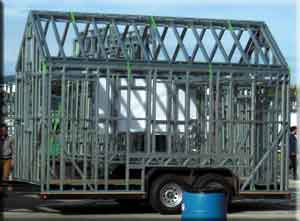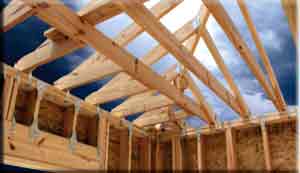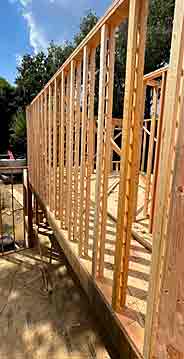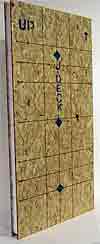Tiny House Framing: Steel, Wood, or SIPs?
Let’s look at the types of tiny house framing to determine which best fits your needs, design, and skill level.
Steel Framing
Steel frames are 25 times stronger than wood, 30% lighter, and you don’t need to add hurricane brackets or other structural enhancements. They are rustproof and pest-proof. So why would anyone use anything else?
Because: metal is 400 times more conductive to “heat bleed” than wood. Extra steps need to be taken to prevent thermal bridging.
Also, metal is more expensive than wood. There are only a few companies in the country that make steel framing. Here is a link to Volstrukt. If you bring the trailer to them, they will fabricate and assemble the frame for you in in a matter of days. You need to have your framing plan firm to the smallest detail because these are difficult to change. They can also fabricate the beams necessary and ship them to you for assembly. You can, with a little extra time, fabricate your own metal framing.
To build or not to build your own metal frame?
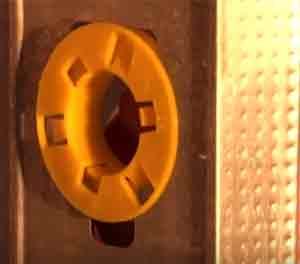
Metal studs require grommets like this for electrical wiring pass through. Click on image to learn more.
Depending on your level of construction abilities, or lack of abilities, you can now order your tiny house on a trailer, framed and dried in with insulation and windows installed. This can really be a time saver and get you a superior product to begin with.
But if you’re really interested in doing this yourself, let’s look at the pros and cons.
As a TV installer I really disliked steel studs. It’s way harder to bolt things to your walls. You can’t just wrench in a bolt and expect it to hold like you can with a wood stud. If you know exactly where your TV is going to go, you can add a wood insert into the metal stud before closing the wall for the bolt to grab. This would need to be done with everything else that needs a firm anchor, like cabinets.
If you feel that you’re up to the task, you can buy steel studs in the same standard lengths as wood studs and assemble it yourself. Here is a great video of a couple who used steel framing for their tiny home:
Wood Framing
Wood: Framing with wood is easier than metal, and the methods are well known. Lumber can be easily obtained. However, framing methods need to be adjusted to take into account the movement and bouncing of a Tiny House On Wheels. Nailed joints will loosen when the structure is moved. For that reason and more, I recommend screws even though that will take a lot more time and effort. In addition, wood beams are not necessarily straight. If you are buying your lumber you can carefully inspect each piece, but if the lumber store is dropping off a pallet, you can be sure that some of the wood will be twisted or curved.
-
Smart Framing
- “Smart Framing” allows weight savings, better insulation, and several other smart ideas. Read my blog post for more on smart framing.
-
Hurricane Brackets
- You will need to install Simpson Strongtie hurricane brackets and other metal corner supports to account for the high wind and shaking encountered during a move.
- Here is the Simpson Strongtie High Wind-Resistant Construction Application Guide.
Screws or Nails?
Nails have a higher shear strength than screws and can be banged in fast with a nail gun. Nails can be very small, which is useful for fine trim work. Small nails will not split the wood and do not require a pilot hole. Finish nails are great when you don’t want to see the head of a screw.
However: nails will loosen with vibrations. Extreme cold temperatures can literally blast them right out of exterior walls.
Screws have greater tensile strength than nails. The threaded shaft will not vibrate loose as easily as nails, which is great for a mobile structure. They can pull sections of wood together, but often require a pilot hole to prevent the wood from splitting. You would use screws to attach your kitchen cabinets to the wall. Screws are more easily removed.
Selecting the right fastener for the job is important.

tStud™: Uninsulated, thermally-broken wall studs
Easily replaces traditional lumber, no need for additional training to install, and gives the builder flexibility to use almost any type of insulation.
The unique engineered design of Tstud™ “breaks” the thermal bridge present in traditional studs that allow for the transmission of temperature between the exterior and interior of your home. By eliminating this bridge with Tstud™ thermal break wall studs, the interior temperature of your home becomes virtually unaffected by the temperature conditions outside.
SIPs
SIPs (Structural Insulated Panels): I cannot express strongly enough my dislike of this building method. These are delivered, pre-made, to your design specifications. They can be assembled very fast. Tunnels through the foam filling are created for plumbing, electrical, and other infrastructure installation. However, I guarantee you will not have thought of everything. You’ll end up tunneling through hardened foam for hours, popping holes everywhere, trying to get wires where they need to go.
If a contractor tells me they are using SIPs, I immediately triple my cost estimate and mentally prepare for some hard work days. Additionally, if an area of a SIPs panel gets damaged by water or other condition, you may need to replace the entire panel.
RV companies use SIPs because they can engineer and mass produce entire walls for instant construction. Sprout Tiny Homes made 38 tiny homes for Aspen Skiing Company in just six months. It works for this application because they are all the same. SIPs are very strong and have great insulating qualities, but are very heavy. Their tinys all have three axles and required a major towing vehicle to move them.
In my opinion they’re just not right for the DIY crowd.
Quality tools will make your job easier
Visit this page for my Top Ten Tools you must have to build a tiny house.
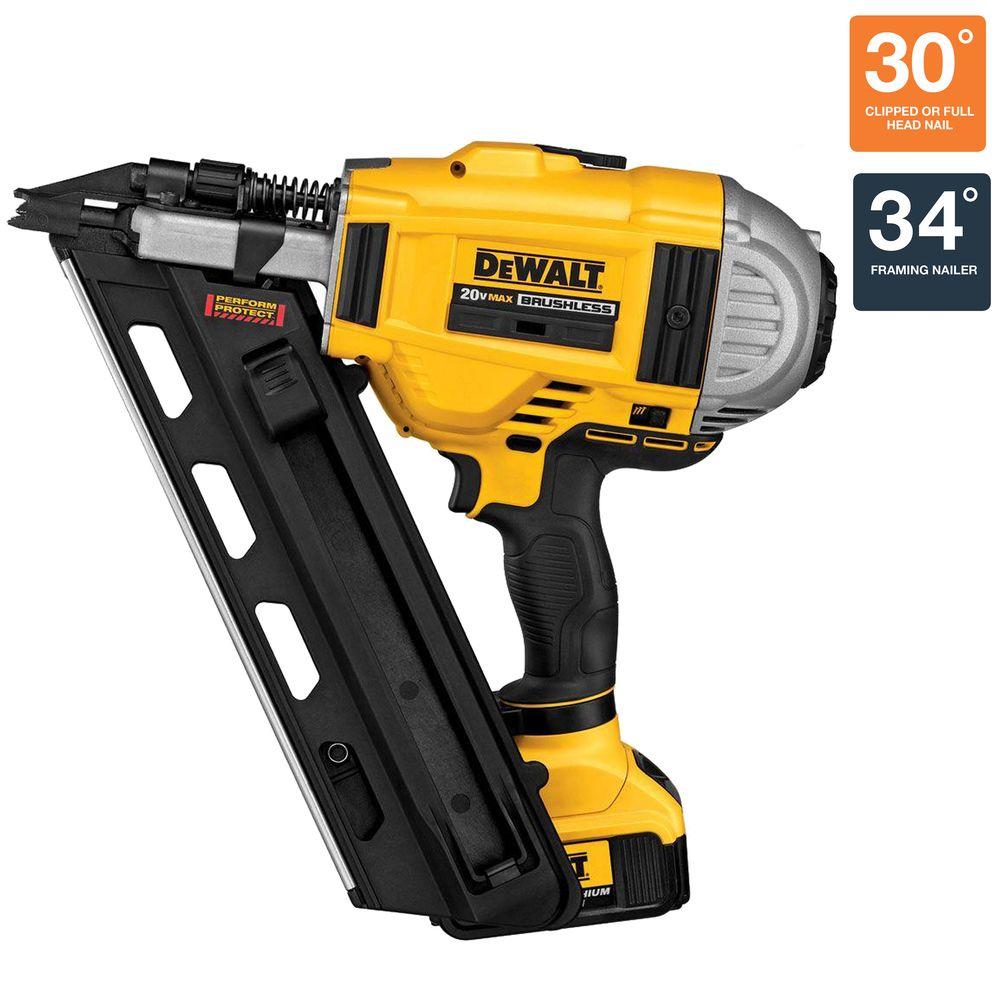 Here is our pick for a great nail gun:
Here is our pick for a great nail gun:
DEWALT, 20-Volt MAX XR Lithium-Ion Cordless Brushless 2-Speed 33-Degree Framing Nailer with Battery 4Ah and Charger
The DEWALT 20-Volt Max Brushless 2 Speed Framing Nailer perfect for maneuvering into tight spaces. The cordless nailer doesn’t need any messy fuel or loud compressors to get the job done. This nailer accepts any 30° – 34° Paper Tape Framing Nails.
Tiny House Framing Structural Strength
Here is an excellent YouTube® video series from Tiny Nest. This episode covers tiny house structural strength. Jake is building a wood framed tiny home and goes into detail about attaching the framing to the trailer and other structural members to prevent “racking” (pulling the frame out of square) when the home is moved.
Here is another great resource from Shed Mobile Habitat Project website about structural strength for tiny house walls.
Adding metal strapping to prevent “Racking” in tiny house framing

In this image, captured from the video above, we see the metal strapping run diagonally of the sides and continuing around the corners.
This will hold the framing in square during acceleration, braking, turning, and hitting bumps. Use this link for a 200 foot roll. Trust me, you will need that much to secure a frame.
The metal strapping disappears under the final wall covering, whatever that ends up being.
Use the same metal strapping to avoid blow-over
See details on how to prevent tiny house blow-over on this page of the Tiny Life Consulting website: Preventing Tiny House Blow-over
More pages of Tiny Life Consulting you’ll be interested in:
Saving Weight On Your Tiny House Build
Best Way to Insulate A Tiny House
Saving Weight On Tiny House Tile


